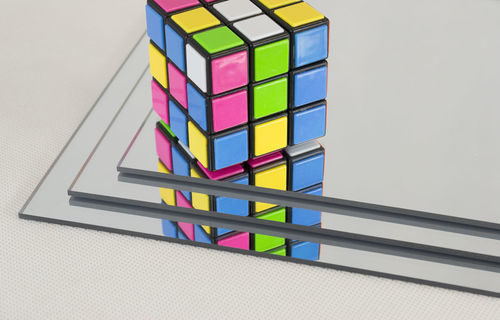Using acrylic mirrors in place of a glass mirror is becoming an increasingly popular trend for DIY and construction projects. We take a closer look at the acrylic material to see what makes it such a popular alternative and to see whether glass can still be useful.

Acrylic Mirrors
- Acrylic mirrors are lightweight, making it easy to manoeuvre and fix into place.>
- It is impact resistant and shatterproof, perfect for use in areas where health and safety are a concern.
- They have easy to clean surfaces, that are less likely to stain or smear.
- Popular for use in areas such as gyms, horse stables, dance studios, schools and public areas, where impact may be a risk and attention to public safety is required.
- They are UV resistant and will not discolour.
- It is a strong and durable material.
- Easy to cut into shape as required without chipping or splintering.
- Cost-effective for large amounts of acrylic mirrors.
- Acrylic mirrors should not be used outdoors as they may absorb moisture if exposed to high humidity or damp environments. Use an aluminium composite mirror instead.
Glass Mirror
- Glass will not warp or become distorted.
- If used in thick width measurements, glass is surprisingly strong.
- Glass will offer a perfect reflection as a mirror.
- If you are buying a decorative mirror, most designs on the market will be made from glass as this has been the traditional material over the years.
Key Differences, Acrylic Mirrors vs Glass
- Acrylic is not as rigid as glass.
- Acrylic may absorb moisture if used outside, so use, specific garden mirrors, made from glass or aluminium composite mirrors instead.
- Acrylic mirror is much lighter than glass, making them easier to move around and putting less pressure on the surface you attach them to compared to glass.
- Glass is heavier than acrylic, so not as versatile or easy to mount.
- Acrylic mirror is more prone to warping when being fixed whereas glass will not. If you still wish to use acrylic, ensure that you mount it onto a flat surface to avoid this.
- Acrylic mirrors can be curved or bent, whereas glass must remain flat.
- Glass mirror will offer a perfect reflection, whereas some types of acrylic mirrors have less reflective quality than others.
- Glass is harder to drill holes into, with the risk of splintering or shattering.
Are Acrylic Mirrors Any Good?
Yes, the benefits of using acrylic mirrors outweigh those of using traditional glass. It is less problematic when being cut to size, easier to install and safer when in position, particularly if it’s in a public area.
At Cut Plastic Sheeting we offer a wide range of acrylic mirror options and would be happy to discuss with you how it would benefit your project.
Sources
https://www.anchuangacrylic.com/acrylic-mirror-vs-glass-mirror/
For more information on Acrylic, Perspex, MDF, Dibond and Polycarbonate please visit our Guide and Blog sections of the website.
Cut Plastic Sheeting are based on the south Coast in Ivybridge, Devon UK. We have a full manufacturing facility which enables us to offer Cut To Size Acrylic as well as Cut To Size MDF. Shop our full range of products, including our Clear Acrylic, coloured acrylic and more recent MDF Wood Sheet ranges.
Our Team are always here to help with any enquiry, please send us an email or for more urgent needs give us a call – Contact Us



